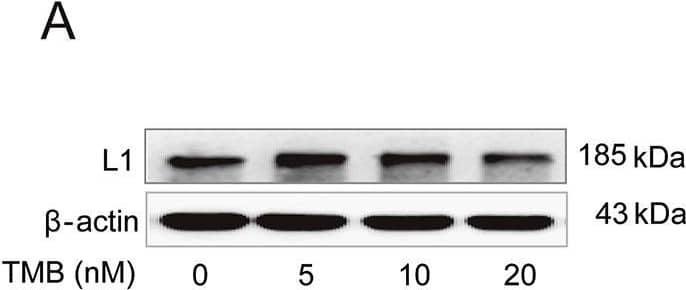Human L1CAM Antibody
R&D Systems, part of Bio-Techne | Catalog # MAB777

Key Product Details
Validated by
Biological Validation
Species Reactivity
Validated:
Human
Cited:
Human, Mouse, Transgenic Mouse
Applications
Validated:
Simple Western, Western Blot
Cited:
Immunocytochemistry, Immunohistochemistry, Immunohistochemistry-Frozen, Western Blot
Label
Unconjugated
Antibody Source
Monoclonal Mouse IgG1 Clone # 84321
Product Specifications
Immunogen
Mouse myeloma cell line NS0-derived recombinant human L1CAM
Met1-Glu1120
Accession # CAA42508
Met1-Glu1120
Accession # CAA42508
Specificity
Detects human L1CAM in direct ELISAs and Western blots. In direct ELISAs and Western blots, no cross‑reactivity with recombinant human (rh) VCAM-1, rhICAM-1, rhICAM-2, and rhICAM-3 is observed.
Clonality
Monoclonal
Host
Mouse
Isotype
IgG1
Scientific Data Images for Human L1CAM Antibody
Detection of Human L1CAM by Western Blot.
Western blot shows lysates of HeLa human cervical epithelial carcinoma cell line and human brain (motor cortex). PVDF membrane was probed with 1 µg/mL of Mouse Anti-Human L1CAM Monoclonal Antibody (Catalog # MAB777) followed by HRP-conjugated Anti-Mouse IgG Secondary Antibody (HAF018). A specific band was detected for L1CAM at approximately 240 kDa (as indicated). This experiment was conducted under reducing conditions and using Western Blot Buffer Group 1.Detection of Human L1CAM by Simple WesternTM.
Simple Western lane view shows lysates of HeLa human cervical epithelial carcinoma cell line, loaded at 0.2 mg/mL. A specific band was detected for L1CAM at approximately 337 kDa (as indicated) using 10 µg/mL of Mouse Anti-Human L1CAM Monoclonal Antibody (Catalog # MAB777) . This experiment was conducted under reducing conditions and using the 66-440 kDa separation system.Detection of Mouse L1CAM by Immunohistochemistry
Analysis of L1 and pCK2 alpha immunofluorescence intensities rostral, central and caudal to the lesion site of the injured spinal cord at 6 weeks post-SCI in mice treated with trimebutine or honokiol. (A,C) Representative images of L1 (A) and pCK2 alpha (C) rostral (1 mm to the lesion center), central and caudal (1 mm to the lesion center) to the lesion site. (B,D) Quantitative analysis of L1 (B) and pCK2 alpha (D) immunoreactivities. *P<0.05, **P<0.01 versus the vehicle control; one-way ANOVA with Tukey's post hoc test; n=3 mice/group. HNK, honokiol; TMB, trimebutine; VC, vehicle control. Image collected and cropped by CiteAb from the following publication (https://pubmed.ncbi.nlm.nih.gov/28714852), licensed under a CC-BY license. Not internally tested by R&D Systems.Applications for Human L1CAM Antibody
Application
Recommended Usage
Simple Western
10 µg/mL
Sample: HeLa human cervical epithelial carcinoma cell line
Sample: HeLa human cervical epithelial carcinoma cell line
Western Blot
1 µg/mL
Sample: HeLa human cervical epithelial carcinoma cell line and human brain (motor cortex)
Sample: HeLa human cervical epithelial carcinoma cell line and human brain (motor cortex)
Reviewed Applications
Read 1 review rated 5 using MAB777 in the following applications:
Formulation, Preparation, and Storage
Purification
Protein A or G purified from ascites
Reconstitution
Reconstitute at 0.5 mg/mL in sterile PBS. For liquid material, refer to CoA for concentration.
Formulation
Lyophilized from a 0.2 μm filtered solution in PBS with Trehalose. *Small pack size (SP) is supplied either lyophilized or as a 0.2 µm filtered solution in PBS.
Shipping
Lyophilized product is shipped at ambient temperature. Liquid small pack size (-SP) is shipped with polar packs. Upon receipt, store immediately at the temperature recommended below.
Stability & Storage
Use a manual defrost freezer and avoid repeated freeze-thaw cycles.
- 12 months from date of receipt, -20 to -70 °C as supplied.
- 1 month, 2 to 8 °C under sterile conditions after reconstitution.
- 6 months, -20 to -70 °C under sterile conditions after reconstitution.
Background: L1CAM
Long Name
Cell Adhesion Molecule L1
Alternate Names
CAML1, CD171, HSAS, HSAS1, MASA, MIC5, NCAM-L1, S10, SPG1
Gene Symbol
L1CAM
UniProt
Additional L1CAM Products
Product Documents for Human L1CAM Antibody
Product Specific Notices for Human L1CAM Antibody
For research use only
